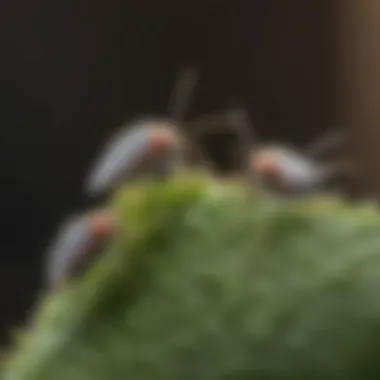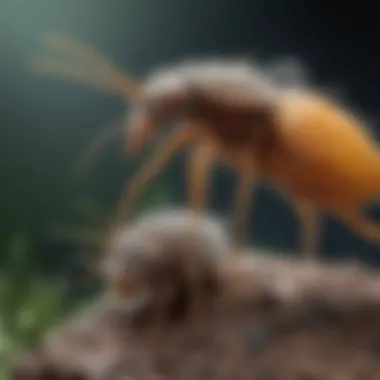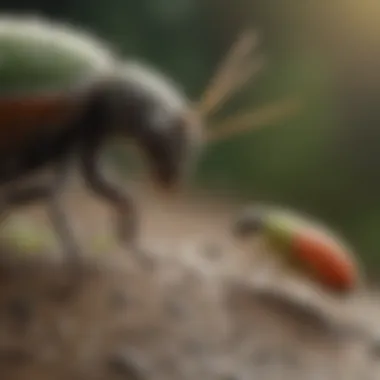Comprehensive Guide to Eliminating Woolly Aphids


Intro
Woolly aphids present unique challenges in gardens. They are not merely pests; they can severely affect plant health and vigor. Understanding the biology and behaviors of woolly aphids is crucial in developing effective control methods. This guide aims to provide invaluable insights on managing these small but problematic insects while maintaining the ecological balance of your garden.
Animal Species Profile
Prologue to Woolly Aphids
Woolly aphids are small sap-sucking insects that belong to the family Pemphigidae. Many people oversimplify pest management as just killing these insects, yet it is essential to recognize that they are part of a larger ecosystems.
Physical Characteristics and Appearance
Woolly aphids are identifiable by their distinct white, waxy coating. This fluffy appearance may resemble little tufts of cotton on plants. They are small, typically measuring between 1/16 to 1/4 inch in length. Their round bodies and short, stubby legs set them apart from other aphid species, an it often makes them harder to spot.
Natural Habitat and Distribution
These pests tend to thrive in temperate climates and can often be found on trees and shrubs. They are commonly spotted on plants like fruit trees, ornamental shrubs, and various herbaceous perennials. Recognizing their preferred habitats helps in implementing effective control methods.
Behavior and Social Interactions
Woolly aphids can form large colonies on infested plants. They excrete honeydew, a sweet substance that attracts ants. This interaction can complicate pest management, as ants often protect aphids from natural predators. Understanding these dynamics is crucial for attempting to combat these pests effectively.
Control Strategies
Eliminating woolly aphids requires a multifaceted approach. Control can be divided into several categories:
Cultural Control
Adopting proper plant care can mitigate infestations:
- Maintain plant health through watering and fertilization.
- Remove heavily infested plants or plant parts instead of trying to treat them.
- Ensure proper spacing between plants to reduce humidity and thereby conditions favored by woolly aphids.
Mechanical Control
Mechanical removal is not always the best route, but may still be useful.
- Use a strong stream of water to dislodge aphids from plants, but do this during cooler times of day to lessen damage to the plant.
- Prune affected branches as soon as an infestation is noticed.
Chemical Control
If things get out of hand, using pesticides may be necessary. Always follow directions, and opt for products that have lower toxicity levels and are less harmful to beneficial insects. For gardeners interested in merits of chemical options, insecticidal soaps or neem oil are often considered effective choices.
Prevention Tips
Handling woolly aphids is not only about elimination. Here are some prevention tips:
- Encourage beneficial insects, such as ladybugs and lacewings, which provide natural pest control.
- Regularly inspect plants for early signs of infestations.
- Implement crop rotation to avoid repeat infestations.
Prevention is the key. Understanding how woolly aphids behave can lead to long-term solutions.
Epilogue
Awareness and understanding play pivotal roles when managing woolly aphids. By following the steps highlighted, gardeners can maintain healthy plants while keeping wooley aphids at bay. Continuous coverage of protective strategies ensures minimal attraction for the pests while maximizing ecological harmony.
Understanding Woolly Aphids
Understanding woolly aphids is crucial for effectively managing their infestations and minimizing plant damage. These pests can severely impact the aesthetic and health of garden plants, causing good gardeners a lot of frustration. The more we know about these insects, the better we can tailor our control methods to specific situations. This section delves into the biology, life cycle, and prevalent species of woolly aphids, providing foundational knowledge necessary to deal with them successfully.
What are Woolly Aphids?


Woolly aphids are small, soft-bodied insects that are typically covered with a white, cottony substance. This makes them relatively easy to recognize, but their lifecycle can be complex. They are members of the Sternorrhyncha suborder, which also includes true aphids. These insects are often found on the stems and leaves of various plants. They primarily feed by inserting their mouthparts into the plant tissue and sucking the sap. This feeding strategy can weaken plants, lead to overall plant decline, and make them more susceptible to diseases.
Life Cycle of Woolly Aphids
The lifecycle of woolly aphids progresses through several stages, including egg, nymph, and adult. In the spring, adult females give live birth to nymphs; they do not lay eggs like many other aphids. These nymphs develop into adults relatively quickly, often within a few weeks, depending on the environmental conditions. Woolly aphids reproduce rapidly, which can lead to sudden increases in their populations. Environmental factors, such as temperature and humidity, can influence their growth rates, making it important for gardeners to be vigilant, especially in favorable conditions.
Common Species of Woolly Aphids
Multiple species of woolly aphids exist, each of which may target particular types of plants. Notable examples include the Eriosoma lanigerum, often referred to as the woolly apple aphid, which feeds primarily on apple trees, and the Sygmorpha americanum, commonly found on various ornamental shrubs. Recognizing these species is important because control methods may differ from one species to another. Therefore, accurate identification is a prerequisite for determining effective management strategies. Understanding the specifics about these common infestations can assist gardeners in implementing targeted actions for control.
Identifying Woolly Aphids Infestation
Identifying a woolly aphid infestation is crucial for any gardener or plant enthusiast seeking to maintain vibrant and healthy flora. Understanding how to spot these pests enables prompt action which can ultimately save plants from severe damage. Regular monitoring is essential. By noticing the early signs of infestation, you can apply control methods more effectively and mitigate the potential for severe damage to your plants.
Signs and Symptoms of Infestation
Woolly aphids are typically not easy to see right away, especially if you do not know what to look for. However, there are several clear indications of an infestation that any attentive gardener can recognize:
- White, fluffy masses: Woolly aphids produce a white waxy substance that can resemble cotton. It tends to cluster near the base of leaves or along stems.
- Stunted growth: When female woolly aphids feed on plant sap, it can impede a plant's growth, leading to explosions of other related symptoms.
- Curling leaves: It's common for leaves to become distorted or curl when infested with woolly aphids. This is a result of the sap being drained.
- Honeydew deposits: Woolly aphids secrete a sticky substance known as honeydew. An increase in sooty mold from this rise often can also be noted surrounding affected plants.
- Presence of ants: Ants are attracted to woolly aphids for their honeydew secretion. If you start seeing ants, it's worth investigating if they are tending to an aphid colony nearby.
Damage Caused to Plants
Woolly aphids can be exceedingly damaging to various plant types. Their feeding behavior primarily targets the plant sap, which contains essential nutrients necessary for plants’ vitality. Here are the following damaging effects woolly aphids might inflict:
- Nutritional Deficiency: Regular feeding can lead to lack of nutrients, making domains more susceptible to other diseases or infestations running arises, hindering overall plant health.
- Growth Deformities: Plants may become stunted or develop growth deformities if the aphids infest before the plant reaches its maturity. Certain crops may yield poorly.
- Severe Fungal Issues: The sticky residue and honeydew can foster fungus, often resulting in a significant health deterioration through sooty mold development and impacting the plant’s ability to undergo proper photosynthesis.
- Long-Term Damage: Continued infestations lead to cumulative stress on the plant and might result in its premature death.
In summary, recognizing the signs and associated damages caused by woolly aphids is imperative for protecting plants. Having a requisite knowledge of potential symptoms can facilitate timely action, shielding plants from severe destruction, ensuring their longevity and beauty.
Cultural Control Methods
Cultural control methods play a vital role in managing woolly aphid infestations. These strategies focus on enhancing plant health and creating an environment less conducive to disease and pest proliferation. Proper cultural practices result in healthier plants, which naturally exhibit more resistance to pest attacks. For peopel taking care of gardens, introducing good practices can be a long-term solution to prevent woolly aphids in the first place.
Maintaining Plant Health
Keeping plants healthy is the foundation of any effective aphid control strategy. Healthy plants are more robust against aphid infestations. Routine checks ensure that plants receive a proper balance of water, sunlight, and nutrients. Proper pruning of dead or overlapping branches enhances air circulation, which reduces humidity around the plants. Healthy foliage is naturally distasteful for aphids, so paying attention to plant wellness can lower the chances of infestation.
- Regularly inspect your plants for any signs of pests or abnormalities;
- Implement a yearly schedule for pruning to remove obstructions.
Proper Watering Techniques
Watering methods influence plant growth, making it a crucial aspect of cultural control. Over or under-watering can stress plants, making them more susceptible to hybrids. Drip irrigation remains optimal, providing water directly to the roots without wetting the leaves. Wet foliage can promote fungal diseases that attract pests.
- Ensure the soil drains well to avoid stagnant water;
- Water in the morning, allowing foliage to dry during the day.
Nutrient Management
Nutrient management enhances weaponry against aphids. Adequate nutrients make plants resilient, while over-fertilization can increase soft, sappy growth that aphids prefer. Amending soil before planting with compost and organic fertilizers can support robust root systems. Standard practices involve pH testing and analysis, ensuring nutrients remain available to your plants.
- Opt for balanced fertilizers with essential micronutrients;
- Monitor soil health regularly through testing and observation.
Adequate cultural practices ensure that plants remain strong, resilient, and less inviting for woolly aphids.
Mechanical Control Options
Mechanical control involves physical measures to manage woolly aphids. These methods are often more environmentally friendly ad can protect your plants without harmful chemicals. Using mechanical strategies is beneficial in gardens where prevention and quick action are needed. Moreover, they often provide immediate results, making them essential for gardeners looking to maintain the health of their plants.
Handpicking and Removal
Handpicking woolly aphids can be an effective way to control small infestations. This method involves thoroughly checking your plants for clusters of aphids, which often hide under leaves or near stems. The process is simple and requires no special equipment aside from basic gloves.
When you spot an infestation, gently wipe or scrape them off using your fingers or a cloth. Place any removed sap-sucking pests in a container with soapy water to dispose of them safely.


- Pro tip: Regularly inspect fragile young plants for woolly aphids, as these are more susceptible.
Using Water to Dislodge Aphids
A strong blast of water can dislodge woolly aphids from plants effectively. This method works particularly well for shrubs and trees. You can use a garden hose with a nozzle or a strong spray setting. The powerful spray can eliminate a significant number of aphids without introducing chemicals to your gardening environment.
- Ensure the water is not too high pressure; this could damage plant leaves or stems.
- Spray the infected areas early in the morning or late afternoon to prevent sunburn to leaves.
Using water is not just mechanical; it also helps reinvigorate the plants, cleaning dust and other potential pests.
Traps and Barriers
Using physical traps and barriers can prevent woolly aphids from accessing your plants. These methods not only keep pests away but can also alert you to the presence of insects.
- Sticky Traps: Position yellow sticky traps around infested plants. When aphids land on the yellow surface, they will get stuck.
- Row Covers: Use floating row covers to physically shield young plants from aphids. This protects them until they establish stronger defenses.
- Floating Barriers: Plant stakes with thin mesh screens can block pests while allowing sunlight and water through.
In summary, while chemical controls are useful, mechanical methods should not be overlooked. They create a safer garden environment and contribute to the overall understanding of pest management in various horticultural practices.
Chemical Control Strategies
Chemical control strategies for eliminating woolly aphids can serve as effective solutions, especially when other methods do not yield satisfactory results. These strategies encompass the use of targeted pesticides designed to disrupt the life cycles of these pests while minimizing harm to the plants. Chemical options should be opted for thoughtfully, appreciating both their potential effectiveness and the implications for the surrounding ecosystem.
Insecticidal Soaps
Insecticidal soaps have emerged as a key player in chemical control of woolly aphids. These products are made from naturally occurring plant oils and fats that kill pests through contact. Once sprayed, insecticidal soap penetrates the soft body of the aphid, causing dehydration which leads to death. The appeal lies in their relatively low toxicity to wildlife and humans, making them a viable choice for gardeners who wish to maintain an environmentally friendly approach.
It is best to target the aphids directly, especially when populations are small. Timing of the application is critical; treatment should preferably occur in the early morning or late afternoon to avoid evaporation from heat, maximizing the soap’s efficacy.
Systemic Insecticides
Systemic insecticides are another option for tackling woolly aphids. Unlike contact pesticides, these travel through the plant’s vascular system. When aphids feed on the sap, they ingest the insecticide, leading to their demise. These chemicals offer a more extended control period and can be particularly useful for severe infestations where immediate action is needed.
However, it is important to consider the implications of using systemic insecticides. They may affect beneficial insects like pollinators if the chemical leaches into flowers. Selecting systemics that are specific ethical options or targeted formulations can help reduce unwanted impacts on the overall garden ecosystem.
Neem Oil and Its Effectiveness
Neem oil is derived from the seeds of the neem tree, and it exhibits insecticidal properties that make it effective against woolly aphids. Neem acts as both a repellent and a growth regulator. When applied, it disrupts the hormonal systems of the aphids, preventing them from maturing and reproducing. Additionally, neem oil targets a variety of soft-bodied insects, making it versatile for gardeners facing multiple pest types.
While neem oil is safe for humans and pets, its effectiveness can be impacted by environmental conditions. Applications should be done when temperatures are cooler to avoid quick evaporation that compromises its efficacy.
"Using chemical control strategies can be beneficial, but a conscientious approach will enhance outcomes without compromising environmental integrity."
Biological Control Agents
Biological control agents are a significant aspect of pest management, particularly when dealing with woolly aphids. By relying on the natural ecosystem to combat these pests, gardeners can adopt strategies that minimize dependence on chemical pesticides. This approach not only contributes to a healthier garden but also preserves the environmental balance.
Benefits of Biological Control
- Sustainability: Encouraging natural predators of woolly aphids promotes a self-sustaining ecosystem in the garden. Over time, these predators can keep aphid populations in check without human intervention.
- Reduced Chemical Use: Many gardeners prefer organic methods due to their commitment to ecological wellness. Biological control agents offer a solution that aligns with this ethos, reducing reliance on synthetic chemicals that may harm beneficial organisms.
- Target Effectiveness: Unlike broad-spectrum insecticides that often kill both pests and beneficial insects, biological controls specifically target woolly aphids, minimizing collateral damage to non-target species.
Using these agents can bring long-term benefits, but it's essential to carefully evaluate which agents to introduce and the timing of their introduction. Understanding the life cycle of woolly aphids allows for better planning when integrating biological controls into your pest management strategy.
Natural Predators and Their Role
Gastropods, predatory insects, and other biological agents can play crucial roles in managing woolly aphid populations. These natural predators include lady beetles, lacewing larvae, and certain parasitic wasps. Each of these predators contributes uniquely to the task of controlling aphid populations.
Lady Beetles
Lady beetles are arguably the most well-known aphid predators. Their voracious appetite allows them to consume large numbers of woolly aphids quickly. Adult lady beetles can eat hundreds of aphids each day. Bringing them into your garden can provide an effective method of aphid control, especially during peak infestation periods.


Lacewing Larvae
Lacewing larvae, also known as
Preventative Measures
The concept of preventative measures is central to managing woolly aphids effectively. By understanding and implementing these strategies, gardeners can not only address existing infestations but also minimize the likelihood of future outbreaks. This proactive approach emphasizes awareness, commitment, and adaptability in various gardening practices, protecting not only the plants but the overall ecosystem.
Regular Monitoring and Inspections
Regular monitoring and inspections are essential components of an effective pest management strategy. By routinely checking plants, gardeners can identify growth patterns, early signs of aphid presence, and potential vulnerability in the ecosystem. This vigilance often acts as the first line of defense. Conducting a thorough inspection involves looking for elements such as woolly masses, leaf discoloration, or sticky residues on leaves—these signs point to possible aphid infestations.
Consider establishing a schedule for these activities. Weekly checks, especially during warmer months, create a habit that reduces the chances of overlooking subtle signals. Additionally, collaboration with local gardening communities can offer insights and shared experiences regarding effective inspection techniques. Keep your tools customized and ready for examination—magnifying glasses are invaluable here. Clear communication regarding the status of plants enhances both immediate action and long-term prevention strategies.
Choosing Resistant Plant Varieties
Selecting resistant plant varieties can significantly bolster efforts against woolly aphids. Certain species of plants display built-in resistance, making them less appealing to these pests. This natural resistance can limit infestations and minimize the need for chemical treatments. Researching and choosing these varieties can be a game changer for home gardeners and professional horticulturists alike.
Gardens that feature a diversity of plants tend to experience fewer aphid problems. Native plants are often worth recommended as they are adapted to local conditions and usually resistant to local pests. When drawing insights on resilient species, resources like the Cooperative Extension System provide valuable directives. Seeking expert knowledge on which plants suit a given environment will inform better choices.
It is also advisable to combine resistant varieties with regular cultural practices. This interdependency is key, allowing breeders and gardeners alike to draw on nature’s resilience combined with smart gardening practices for maximized outcomes.
Choosing resistant varieties alongside other preventative methods tends to create a sustainable gardening environment.
Environmental Factors Influencing Infestation
Understanding the environmental factors that contribute to woolly aphid infestations is crucial for effective management. Key conditions such as temperature and humidity can directly influence aphid populations. By recognizing these factors, gardeners and horticulturists can develop strategies to minimize risks and prevent outbreaks. This segment explores how temperature fluctuations and humidity levels play a critical role in the proliferation of woolly aphids in various settings.
Temperature Effects on Aphid Populations
Temperature exert a significant influence on woolly aphid dynamics. These insects thrive in warm environments, typically around 65–75 degrees Fahrenheit. Inside this ideal range, woolly aphids can reproduce rapidly. Warmer temperatures shorten their developmental time and increase reproductive rates, making infestations more prevalent during warm spells.
As temperatures rise, the life cycle of woolly aphids accelerates. One generation can mature in as little as 7-14 days under optimal conditions. Correspondingly, cooler temperatures may slow their growth but do not eliminate them. It's vital to recognize that even slight increases in temperature can lead to peak populations. This fact emphasizes the importance of controlling the environments around cultivated plants, including adequate shading and ventilation.
Key Points on Temperature Influence:
- Ideal Range: 65–75°F promotes fastest growth.
- Reproduction Speed: Warmer climates lead to quicker generations.
- Management Tactics: Cooling strategies may help reduce populations.
Humidity and Its Role in Infestation
Humidity levels also get essential for the well-being of woolly aphids. These pests prefer humid conditions, which can aid their persistence and reproduction. High humidity, often exceeding 60%, creates favorable environments for aphids to thrive. In fact, lush, dense foliage provides ample moisture, allowing aphid populations to intensify.
Conversely, low humidity can be detrimental to woolly aphid survival. A dry atmosphere often stresses these pests, causing them to be less active and reducing reproduction rates. Proper outdoor humidity levels thus play a dual role in both fostering and inhibiting aphid populations. For example, areas with high humidity can enable improved survival, while “aired out” gardens appear less susceptible.
Important Considerations Regarding Humidity:
- Optimal Conditions: Humidity above 60% tends to promote growth.
- Impact of Dry Weather: A drier environment can decrease activity and reproduction.
- Gardening Strategies: Managing humidity makes gardens less inviting for aphids.
Understanding temperature and humidity is vital for effective control of woolly aphid infestations. Adapt garden conditions in a way that makes them less hospitable to these pests, thus enforcing a more desirable growing environment using techniques validated through observation of these factors.
Ending
In the context of garden management, understanding how to tackle woolly aphids is essential for maintaining plant health and vitality. This article has examined a broad spectrum of control methods, each with distinct advantages and limitations. Combining these methods right can lead to successful outcomes in aphid control.
Effective control is not just about immediate action against these pests but also about fostering a long-term strategy. Each method discussed—be it biological, mechanical, or chemical—offers different levels of impact. Some strategies might focus on direct removal, while others work to establish an unfavorable environment for the aphids.
Summarizing Effective Control Methods
The journey through effective woolly aphid management can be outlined as follows:
- Cultural control revolves around practices like maintaining plant health, ensuring proper nutrient levels, and considering resistant varieties. These steps strengthen plants against possible infestations.
- Mechanical options provide tangible methods to dislodge aphids. Techniques like manual removal and employing innovative trapping solutions serve as direct countermeasures.
- Chemical strategies, while sometimes necessary, should be applied judiciously. Using insecticidal soaps or systemic solutions can yield quick results, but also raise environmental concerns, prompting the need for careful consideration before application.
- Biological controls harness nature's balance through introducing natural predators. This sustainable method can lead to long-term population control with minimal side effects.
Aggressively monitoring and adopting adaptable responses is crucial. An integrated pest management approach maximizes effectiveness, combining elements from all strategies to respond to the specific situation.
Ultimately, education about environmental factors that contribute to infestation can enhance awareness and preemptive measures. To lessen risks, managing temperature and humidity levels is vital.
Through this combined approach, gardeners can reclaim the integrity of their plants, turning the tide against woolly aphids and ensuring sustained growth prospects.





